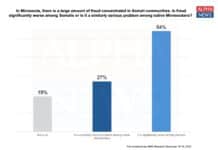
(Center of the American Experiment) — In November 2021, the Federal Reserve Bank of Minneapolis released two reports — each analyzing the impact of minimum wage hikes in the cities of Minneapolis and St. Paul between 2018 and 2020. Generally, the two reports found that minimum wage hikes in the Twin Cities cost jobs, especially in the restaurant industry.
However, unlike in Minneapolis, St. Paul’s minimum wage didn’t kick in until 2020, meaning that the changes that were observed were a result of employees responding in anticipation of the implementation of the law. Additionally, as the Federal Reserve Bank cautioned, in 2020 the Twin Cities experienced two unprecedented events, namely the civil unrest following the death of George Floyd as well as the COVID-19 pandemic, events which could have possibly had some impact on the job market as well, making it hard to conclusively credit these findings totally to the minimum wage effect.
Luckily, last week, the Federal Reserve Bank released two new reports which add two years of data for both Minneapolis and St. Paul allowing a better analysis of the effects of minimum wage on the Twin Cities, especially at a time when states were recovering from the COVID-19 pandemic. Furthermore, unlike the previous studies which compared the Twin Cities to other cities in Minnesota, these new studies compare the Twin Cities to cities of similar size and similar exposure to COVID-19 around the country that did not raise their minimum wage, allowing for a better comparison. The additional data also allows us to see how St. Paul’s economy fared after minimum wage hikes kicked in, unlike before.
Much like the 2021 papers, the new studies do find that minimum wage hikes in the Twin Cities cost jobs. These effects were larger for retail and restaurant industries, in “lower-paying establishments, and for lower-paid workers.”
Specifically for Minneapolis, by 2021Q4, the minimum wage hike led to
“an average decline in jobs of 1.7 percent, an average decline in hours worked of 1.3 percent, and an average decline in wage earnings of 1 percent. The largest effects are found in the restaurant and the retail industries, in lower-paying establishments, and for lower-paid workers.”
In the retail industry specifically, the minimum wage hike reduced jobs by 28 percent, hours worked by 20 percent, and earnings by 13 percent.
And in St. Paul, by 2021Q4, the minimum wage hike led to
“an average decline in jobs of 2.2 percent, an average decline in total hours worked of 2.3 percent, and an average decline in wage earnings of 2.1 percent. The largest effects are found in the restaurant and the retail industries, in lower-paying establishments, and for lower-paid workers.”
In the retail industry, the minimum wage hike reduced jobs by 23 percent.
The minimum wage is no magic wand
Politicians like Bernie Sanders like to periodically call out for minimum wage hikes (as he is doing now), claiming that raising the minimum wage would magically raise workers out of poverty. The research, however, continues to show that there are massive tradeoffs to raising the minimum wage.
While other workers may indeed get more money, others lose their jobs entirely. And in some instances, wage losses among those who lose their jobs outweigh the additional money made by those who maintain their jobs at the higher wage, resulting in a net reduction in wages. As the Fed study finds, this is exactly what happened in both St. Paul and Minneapolis between 2018 and 2021.









